#rhodian trireme
Photo

Relief of a Rhodian trireme (warship) cut into the rock at the foot of the steps leading to the Lindos (Greece) acropolis. On the bow stood a statue of General Hagesander (He is said to have successfully led his men against pirates in 190 BC.) the work of the sculptor Pythokritos. The relief dates from about 180 BC.
113 notes
·
View notes
Text
Classical Greek Adventuresses!
So for as long as I’ve been using Hero Forge, I’ve wanted to see more ancient-world aesthetics. And while I’ve managed to design some Legionary and Gaul minis, I’ve always felt too limited in ancient apparel to explore Classical Greek minis until now. But with the release of two exomis tunic tops and a leg wrap, I’ve finally had the chance to go nuts with the aesthetic. Delightfully, the top works really well with most of the skirts and dresses Hero Forge has to offer. As such, I went ahead and designed adventuresses for each of the twelve D&D classes. (Now if they’d give us a linothorax design and proper Greek helmets, I’d love them forever...) @weareadventurers
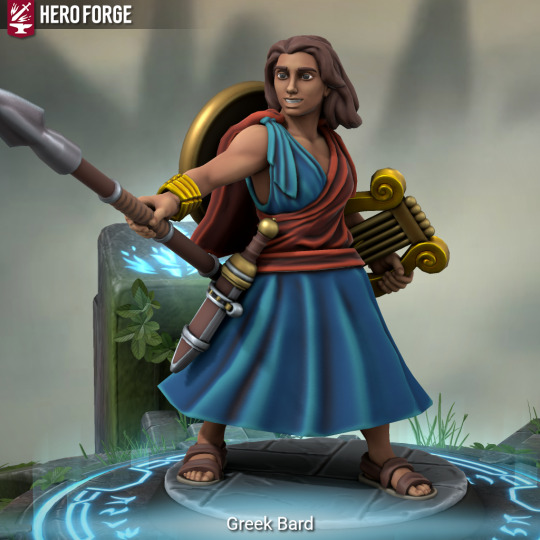
Klyte the bard, daughter of the Muse Calliope. From the city of Oreos on the island of Euboea, Klyte is very much a free spirit. Equally skilled with a lyre, a song, or a spear, she and her friends have traveled much of Greece and Ionia. A lover of food and fun and heroism, she revels in seeking adventure and wooing beautiful men and muscular women.
https://www.heroforge.com/load_config%3D14920803/

Andromakhe the monk, granddaughter of Amphictyonis. Though she grew up in Athens, she was born in the Attic city of Larion. A wrestler, boxer, and pugilist, Andromakhe is deadlier with bare fists than most warriors are with sword and spear. Though married once, she’s rarely found enjoyment in the arms of men or women, preferring travel, study, philosophy, good food, and strong wine.
https://www.heroforge.com/load_config%3D14928391/
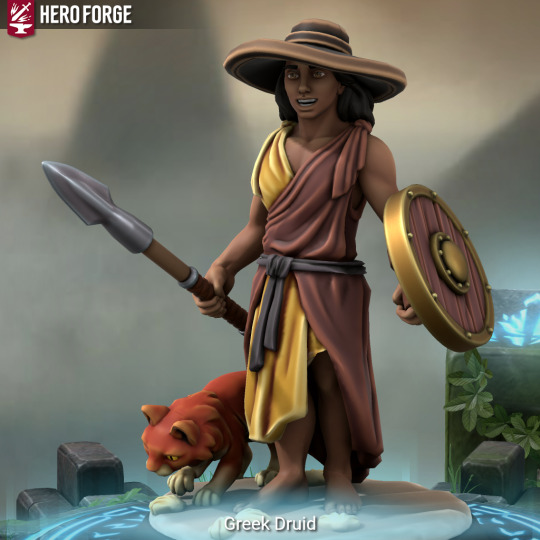
Thetis the druid, a mortal daughter of Persephone and Hades. Born during the summer, Thetis grew up helping her mother with spring plantings and fall harvests, falling in love with the magic of nature. Though she’s spent little time in the underworld, she gets along well with her father and considers Thanatos and Charon her uncles. Her favorite activities include traveling and spending time at the beach with her wife Xylia and their cat.
https://www.heroforge.com/load_config%3D14924362/
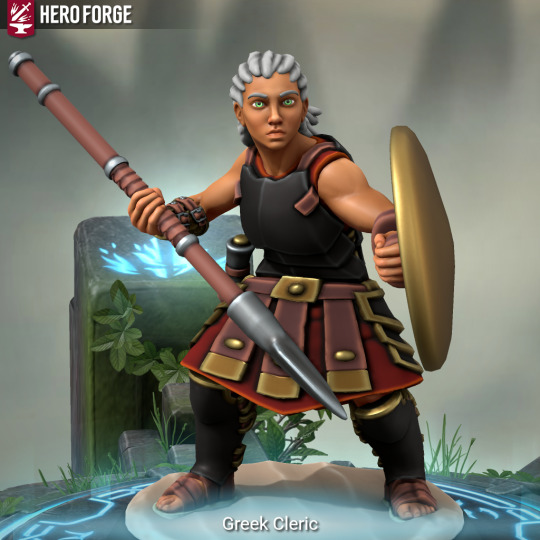
Zeuxo the cleric, transgender granddaughter of Zeus. Zeuxo is a veteran hoplite and a dedicated priestess of Hera, despite being descended from one of Zeus’s by-blows. Originally from Argos, Zeuxo chose the life of adventure and travel somewhat later in life, enticed by Klyte’s stories and songs and tits.
https://www.heroforge.com/load_config%3D14922004/
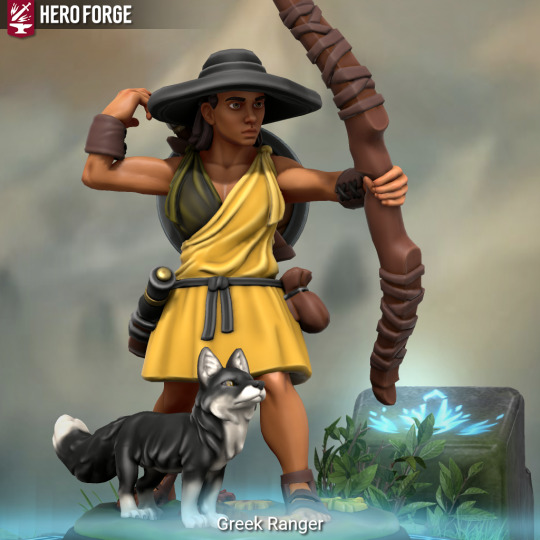
Korrina the ranger, daughter of Britomartis and huntress of Artemis. A Cretan from a township near Kydonia, Korrina has spent much of her life traveling as a huntress, scout, and mercenary toxotes. Though she cares about her friends and finds enjoyment in the arms of strong women, she has always preferred the company of animals to people and the quiet of nature to the bustle of city life.
https://www.heroforge.com/load_config%3D14923271/
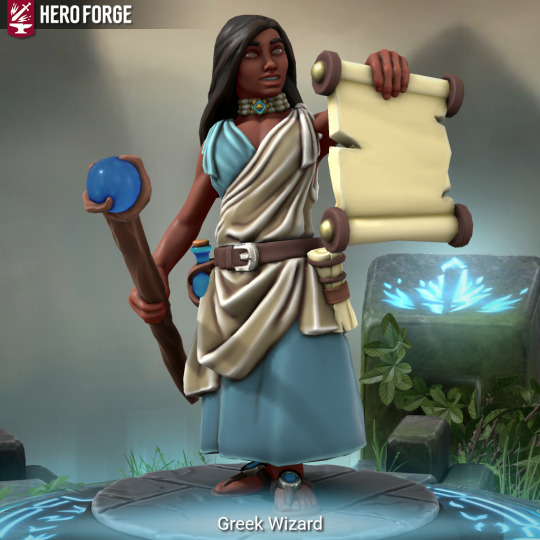
Telesilla the wizard, granddaughter of Triton. Born to a Phoenician mother, Telesilla specializes in water magic and has spent most of her life at sea. Infinitely comfortable aboard ships and with an inherent ability to breathe underwater, she has seen parts of the Aegean sea floor that other mortals can only imagine. Though she loves traveling and cares about her friends, Telesilla frequently thinks of giving it all up to spend more time with her Nereid girlfriend.
https://www.heroforge.com/load_config%3D14940405/
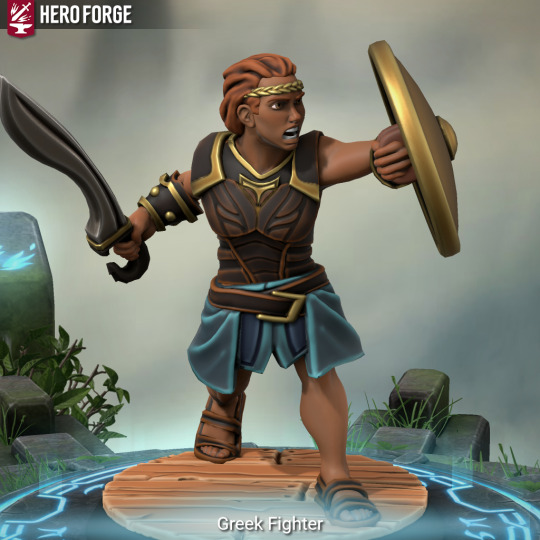
Xylia the fighter, daughter of Arethusa the nymph of spring. Born in Sicily, Xylia fought as a marine aboard Syracusan triremes before meeting and falling in love with the druid Thetis. Xylia forever left the life of a soldier for the life of a wanderer to stay at Thetis’s side.
https://www.heroforge.com/load_config%3D14927692/
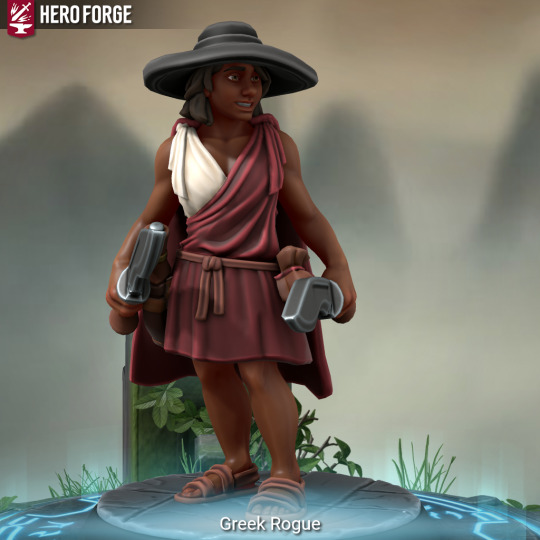
Symaethis the rogue, granddaughter of Hermes. Heiress to a long line of Rhodian pirates, Symaethis grew up sailing and plundering, raiding merchant ships and sea-side towns. Slick with dagger, kopis, and sling, she became captain of a corsair penteconter war-galley at seventeen. Despite her cunning, her ship ran afoul of Ionian triremes off the coast of Samos. Galley split in half and crew slain or drowned, Symaethis was rescued by Telesilla and Andromakhe, joining their band shortly after.
https://www.heroforge.com/load_config%3D14939130/

Lotis the paladin, transgender daughter of Apollo. Though a daughter of Apollo, Lotis instead swore her oath not to a god, but to Soteria, the personification of protection and safety. Born in Thebes, Lotis fought as a hoplite at the side of the famous Sacred Band in her youth and participated in their defeat of the Spartans. Now a free agent, she travels beside her friends, helping people from different parts of the Aegean.
https://www.heroforge.com/load_config%3D14938815/

Nikia the warlock, granddaughter of Hekate. Though trained as a priestess to Persephone, Nikia instead found a patron in Bia, the spirit of force and energy. Often chaotic and easily angered, she loves her girlfriend Pelopia and cares deeply for her friends. Indeed, Pelopia’s kindness and free spirit seems the only thing that consistently tames Nikia’s fury and imbalance.
https://www.heroforge.com/load_config%3D14940052/
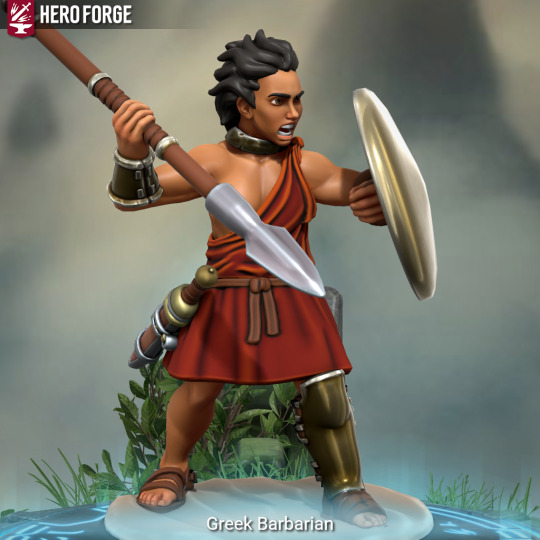
Euryleia the barbarian, granddaughter of Enyo. A Thracian, Euryleia grew up with spears and javelins. Something of a failure as a hoplite, she prefers relying on her own strength and prowess over depending on the support of others. Despite this, she seems to fight well beside her friends and enjoys helping others more than she’d expected.
https://www.heroforge.com/load_config%3D14920727/
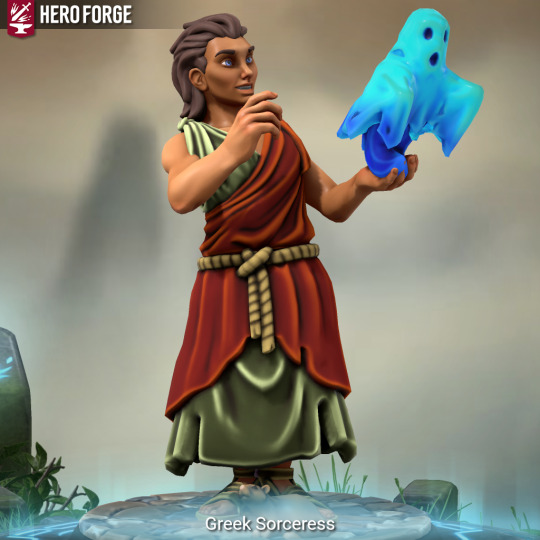
Pelopia the sorceress, daughter of the grace Aglaea. Gifted with a talent for illusions, Pelopia loves showing off her magic and making people laugh and smile. Though her relationship with Nikia seems counterintuitive on the surface, Pelo’s joy and kindness does much to calm Nikia’s instability. Where Nikia’s aggressiveness ruined her previous relationships, her love with Pelopia is filled with only smiles and laughter.
https://www.heroforge.com/load_config%3D14939498/
26 notes
·
View notes
Photo

Nike of Samothrace on the Prow of a Ship (Rhodian marble) with the battering ram. (Louvre Paris, Inv.nr. MA 2369 ). The Nike stands on a block on top of the ship but originally she was directly standing on the ship. The type of ship shown is unknown although some consider it a so called Trihemiolia Rhodian trireme who was very flexible using oars of different length. Dimensions: Height: 2.45m Width: 2.35m Length: 4.3. http://www.hellenicaworld.com/Greece/Technology/en/Trireme2.html
18 notes
·
View notes
Text
Naumachia
The Naumachia, i.e. reenactments of naval battles in the arena or on artificial lakes, probably went back to Gaius Iulius Caesar 46 BC, who celebrated his military successes by presenting a battle on an artificial lake in which biremen, triremen and quadriremen with four thousand oarsmen and two thousand deckhands in battle dress took part, representing the fleets of Tyros and Egypt. The fighters involved in the Naumachia were called Naumachiarii. Like the gladiators they were mostly slaves, prisoners of war or condemned to death. Through a good performance they could fight for their freedom.

The Naumaquia, by Ulpiano Checa 1884
Augustus had a new lake built on the left side of the Tiber after the one built by Caesar had to be filled in again because of the danger of epidemics. In 2 BC, he organised a naval battle there on the occasion of the inauguration of the temple of Mars Ultor. The famous naval battle of Salamis in 480 B.C., in which the Greeks defeated the Persians, was re-enacted. The lake, which measured about 540 by 350 metres, had a small island in the middle, modelled on the bay of Salamis. Thirty birems and trirems were used, along with numerous smaller ships. In addition to the oarsmen, whose number is not mentioned in the sources, there were three thousand soldiers on board the ships.
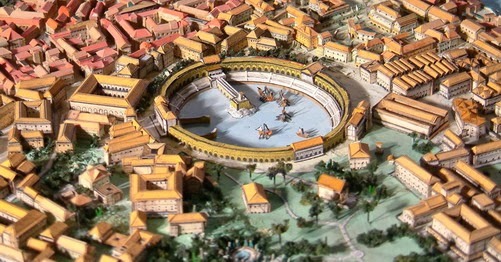
The vetus naumachia, Augustus first build permanent naumachia measuring 540 by 350 metres
The largest known re-enacted naval battle was organised by Emperor Claudius in 52 AD. On trirems and quadrirems 19000 oarsmen and soldiers fought, divided between a "Rhodian" and a "Sicilian" fleet. Before the battle, the participants, prisoners of war and slaves condemned to death, are said to have greeted Claudius with words often associated with gladiators: Ave Caesar, morituri te salutant- Hail, Caesar, the doomed ones greet you. (This greeting is generally associated with gladiators. However, there is no evidence that a gladiatorial fight ever took place in which the gladiators addressed the Roman emperor in this way.)
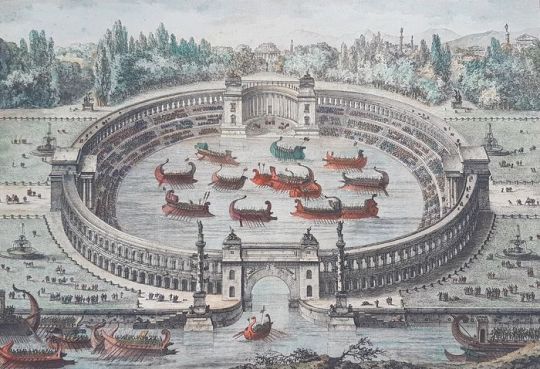
Vue et Plan d'une Naumachie, by S. Berteaux 1800
In an effort to demonstrate their absolute claim to power, the emperors wanted to make an even greater impression on the audience with naval battles integrated into the gladiator games. Caligula was a kind of pioneer in this respect, even if the basin he excavated brought him nothing but scorn, since a single ship could fit into it. Nero went a step further and had a theatre filled with water, in which a naval battle between Persians and Athenians was re-enacted, although Nero was also releasing animals like Crocodiles and other water animals ("sea monsters") into the water. When the battle was over, the water was drained and before the ground was even dry, gladiators were competing against each other.
Emperor Titus was the third emperor to flood a Roman arena and stage a naval battle integrated into the ongoing programme of gladiator fights, all this on the occasion of the opening of the Colosseum. The spectacle in the arena was based on the battle between the Corky-ites and the Corinthians at the beginning of the Peloponnesian War. At the same time he organised a naval battle on the artificial lake that Augustus had had built on the banks of the Tiber.

Cassius Dio writes about this: Numerous men fought as lone fighters, and quite a few groups fought with each other in land and sea battles. For Titus would suddenly fill that very theatre with water and bring in horses, bulls and other tame animals trained to behave in the water just as they would on the water. In addition there were also people on ships. They performed a naval battle there in the role of Corkieans and Corinthians, while others outside the city staged a similar spectacle in the Grove of Gaius and Lucius, in a place that Augustus had had built for this very purpose. There too, on the first day, a gladiatorial fight and an animal hunt took place, with the water in front of the pictures being covered with a wooden floor and wooden stands erected all around. The second day was followed by a chariot race and the third by a naval battle, which was followed by an infantry fight. The "Athenians" defeated the Syracuse - the name under which both parties fought at sea -, landed on the island and conquered a wall built around the monument. (from: Cassius Dio, The Roman History, Epitomy of the Book 66,25,2-4)
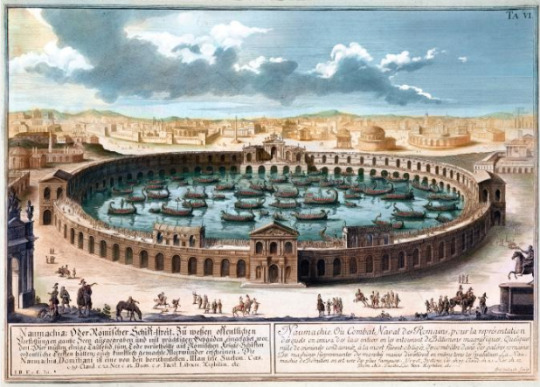
Modern historians are divided on whether naval battles actually took place in the Colosseum, despite there being ancient accounts of them. This 1721 engraving imagines one organized by Emperor Domitian in the Colosseum. Archaeologists calculated how long it would take to flood the area and came to the conclusion that it would take up to three and a half hours. so it was quite possible, although it is likely that there would only have been a small amount of water to hold an event.
Domitian made the Colosseum unsuitable for naval battles, although he had a naval battle held there before, probably to refute the claim that he could not keep up with his predecessor. Domitian had the cavity under the Colosseum converted into a hypogeum, a cell and cage block for gladiators and wild animals, spread over two floors and separated by walls and corridors. Therefore, the theatre could no longer be placed under water. Domitian, however, organised further naval battles, but at a site near the Tiber, where he had a basin dug out and surrounded by rows of seats.
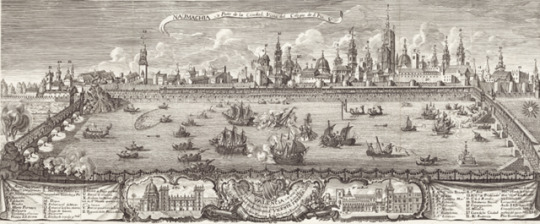
The Naumaquia of 1755. Between the 12th and 13th of July 1755 and to commemorate the third centenary of the canonization of Saint Vicente Ferrer, a Naumaquia took place in the Turia river.
The last staged naval battle was probably organised by Emperor Philip Arabs in 247 AD. Nothing is known about the effort of this Naumachia, so it remains open how great the enthusiasm of the audience was.
But this type of event did not stop there. Even in the later centuries, there were still some Naumachie events to honour great deeds or other festivities. In the baroque period the Naumachia were revived for the amusement of courtly society. For example, naval battles were fought on the (now drained) Brandenburg Lake in Bayreuth, in which numerous actors were killed.
246 notes
·
View notes